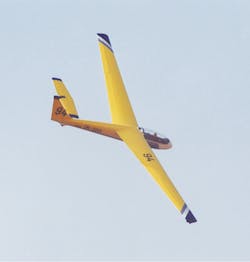MAXWELL AIR FORCE BASE, Ala. – Twelve TG-10B (L-23 Super Blanik) gliders from the U.S. Air Force Academy in Colorado Springs now belong to Civil Air Patrol.
The recent Air Force transfer of the aircraft to CAP is a boost to the Air Force auxiliary’s glider program. It will allow the Air Force auxiliary to replace some of its older gliders and help modernize its existing fleet of 42 gliders.
Ten of the Air Force Academy gliders will be used to upgrade the CAP soaring fleet, but two others not considered airworthy will be stored to supply parts for those that are in use. Eight of the gliders also come equipped with trailers to be used for storage and transportation.
“This comes at a great time,” said Col. Mike Murrell, CAP’s national deputy chief of staff for operations. “The transfer gives us the opportunity to both upgrade the glider fleet and enhance the overall program, which – thanks to the efforts of a lot of dedicated glider and cadet program volunteers – just celebrated its most successful year in recent memory.”
In fiscal year 2012, CAP flew 10,249 glider sorties (mostly cadet orientation and training flights) – more than any year since 2005 when CAP began tracking glider flights online.
“Having these Air Force Academy gliders in CAP’s air fleet will help us provide youth with even more flights in the coming year,” said Murrell. “This is an exciting development, sure to enhance our cadet recruiting and retention efforts.”
A conventional two-place tandem, basic training sailplane, the TG-10B is one of the world’s most common soaring trainers. It has been used by the Air Force Academy for a number of years to introduce its cadets to flight.
Like the Air Force Academy, CAP uses its gliders to introduce America’s youth to flight through its cadet orientation program. The opportunity to fly is a major attraction for cadets; almost 32,000 orientation flights were provided in CAP’s gliders and powered aircraft over the past year.
In addition to its cadet orientation flights, CAP offers three national glider academies and a number of region and wing glider encampments each summer at different locations throughout the U.S. The glider academies and encampments are specifically designed for cadets who want to learn to fly. Participants receive formal ground instruction and cockpit time with a certified flight instructor, and some participants get the opportunity to solo.
Civil Air Patrol, the official auxiliary of the U.S. Air Force, is a nonprofit organization with 61,000 members nationwide, operating a fleet of 550 aircraft. CAP, in its Air Force auxiliary role, performs 90 percent of continental U.S. inland search and rescue missions as tasked by the Air Force Rescue Coordination Center and is credited by the AFRCC with saving an average of 80 lives annually. Its volunteers also perform homeland security, disaster relief and drug interdiction missions at the request of federal, state and local agencies. The members play a leading role in aerospace education and serve as mentors to nearly 27,000 young people currently participating in the CAP cadet programs. CAP received the World Peace Prize in 2011 and has been performing missions for America for 70 years. CAP also participates in Wreaths Across America, an initiative to remember, honor and teach about the sacrifices of U.S. military veterans. Visit www.gocivilairpatrol.com or www.capvolunteernow.com for more information.



